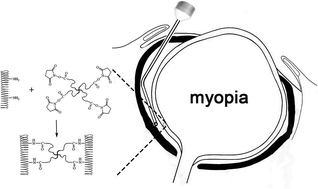Efficacy and safety of scleral crosslinking using poly(ethylene glycol)ether tetrasuccinimidyl glutarate for form-deprivation myopia progression in rabbits
Abstract
Myopia is becoming increasingly prevalent worldwide at an alarming rate. However, no effective treatment is available for inhibiting myopia progression. Materials chemistry advancements have made it possible to regulate mechanical properties and rate of degradation with good compatibility by developing newly crosslinking systems such as the branched polyethylene glycol (PEG) systems. Herein, we presented a PEG molecule with N-hydroxysuccinimide (NHS) ester functional groups at the chain ends as a macromolecular crosslinking agent for the treatment of myopia. We found that the scleral collagen crosslinked with the four-armed star-shaped PEG molecule with NHS ester functional group (4S-PEG) showed better biomechanical properties, increased thermal stability and higher resistance to degradation. 4S-PEG exhibited relatively low cytotoxicity for human fetal scleral fibroblasts. The retrobulbar injection of 4S-PEG at a relatively low concentration (2.5 mM) showed good effective control of the progression of form-deprivation myopia in rabbits. There were no signs of adverse effect or damage by repeated injections with 4S-PEG in rabbits. The results of this work demonstrate that 4S-PEG can serve as a robust macromolecular crosslinking agent and is expected to have promise for application in the treatment of the progression of myopia.



 Please wait while we load your content...
Please wait while we load your content...